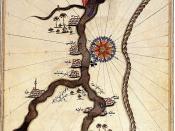Ancient History Draft - Liam Noble
Ms. Cameron
Proof Read by Liam8
The natural environment of Ancient Egypt impacted greatly on Egyptian beliefs and their way of life. During the Old, Middle, and New kingdoms (2780 BC to 1085 BC), the land of Egypt consisted of diverse features of that environment. The Nile river was a vital aspect of Egypt and their culture, as their existence depended on its flooding each year. The Nile also helped shape the Egyptian calendars, which were important in planning their seasons of agriculture. The desert, which held many materials, used in building and crafting, surrounded Egypt, and oases in the desert were of huge importance in their culture. Gods and goddesses were considered highly relevant in the Egyptian culture, as they were respected significantly, and these deities were a huge part of their beliefs. The natural environment was extremely influential in shaping Egyptian life, agriculture and religion, and because of this, the Nile, desert, calendars and the divine beings of Keme connected with them assumed great importance in their culture.
The Egyptian lifestyle centered around the river Nile, and their lives and the Nile were connected through the importance of agriculture and religion. Herodotus regarded Egypt as "The Gift of the Nile". The inundation of the Nile was an annual cycle, in which the waters flooded then receded, and when the flood withdrew, it deposited black silt along the banks of the river. This black silt was essential to irrigate the soil along the banks, and to make the land fertile in order for people to eventually harvest crops (Jones 2013). A specific god, named Hapi, was a god that represented the Nile's inundation. The flooding of the Nile was very important to Egyptians, and because of this, Hapi was worshipped...


